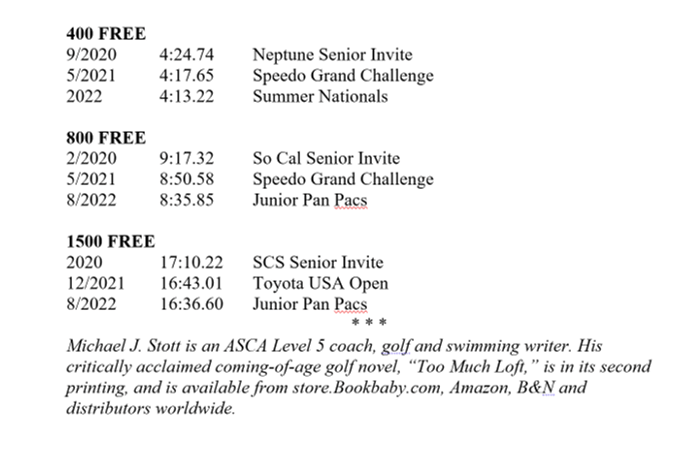A Look At the Development and Training Sets of Rising Star Kayla Han
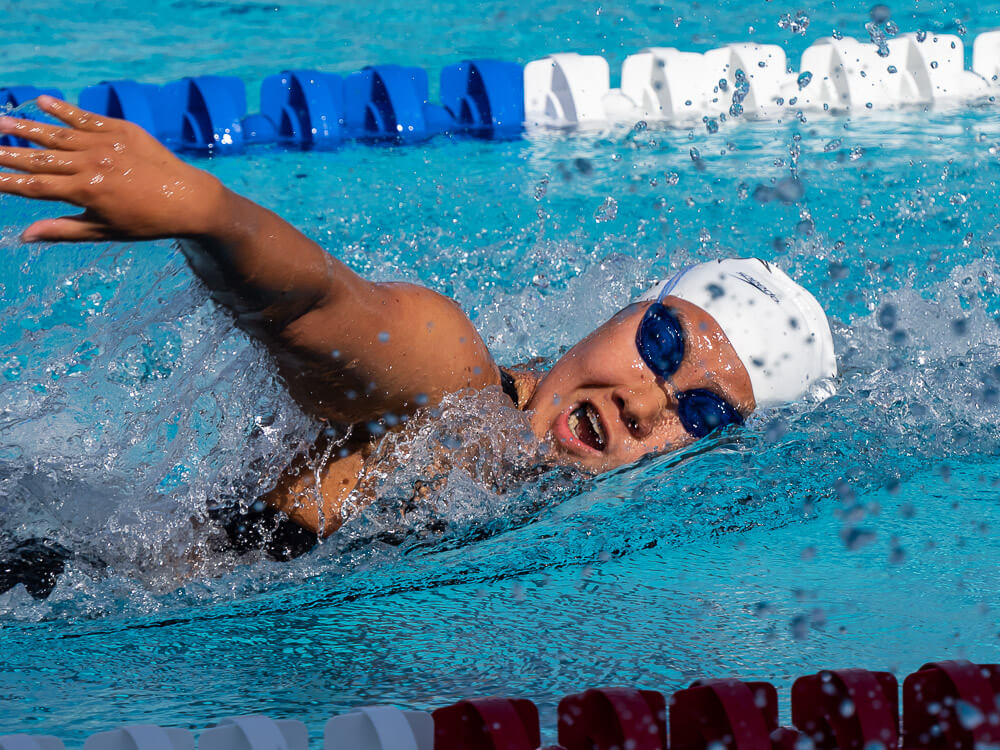
A Look At the Development and Training Sets of Rising Star Kayla Han
You know you are something special when just 13—and the youngest qualifier at the Olympic Trials—Olympic medalist Elizabeth Beisel gushes at your prowess. Now 14, Kayla Han has been on USA Swimming’s radar since she set her first NAG records in the 500-yard free (5:13.45) and the short and long course course 200 IMs (2:11.19, 2:28.70).
All told, she possesses seven NAG records. Among 11-12s, she has two LC distance free marks—400 (4:17.65), 800 (8:50.58)—plus the 400 IM standard (4:50.70). She also possesses the 13-14 SCY 400 IM mark at 4:06.95 and is the fastest 13-year-old ever in the LC 400 IM at 4:46.01. For grins, she topped off her 2022 summer as a silver medalist in the 400 IM (4:43.60) at Junior Pan Pacs.
A mere 5 feet 4 inches tall, Han more than holds her own with her fellow La Mirada team members in southeast Los Angeles County. There, according to her coach, Rick Shipherd, her training has been governed by two tenants:
1. Training and expectations of Kayla should be throttled back to a reasonable percentage of full potential.
2. Diversify everything—event and meet selection, dryland modalities, energy system adaptation and coaching interaction.
From March of 2020 to June of 2021, Han had three coaches: Matt Cervantes (then senior development coach), Cody Davidson (national prep group assistant) and national group coach Shipherd. Each had a distinct influence and something unique to offer, says Shipherd. “Kathy Hall, our age group assistant coach, played an early role as stroke instructor for Kayla.” Hall later became so trusted by Kayla that she attended the Wave I Olympic Trials as her coach.
Head Coach Shipherd looked on and observed: “As an 11-year-old, Kayla emerged as an accomplished age group swimmer, yet she was small and only doing five age group practices a week. At that time, her breaststroke and backstroke had not developed, and her underwater skills were an afterthought.” Thanks to Matt and Cody, those skills and strokes evolved. From March of 2020 through June, those coaches made skill development, workout habits, underwater skill and mechanics the focus of her training.
“In the summer of 2020, and with a return from COVID, we started to move Kayla, now 12, into occasional workouts with the older girls in the national group. U.S. national teamers Taylor Ault and Cathryn Salladin were in the lanes next to Kayla as mentors and took her under their wings. Early on, it became obvious that she had a unique aerobic capacity and a mindset that matched that kind of work perfectly. As Kayla began to attack longer and harder sets, Taylor began calling her ‘Baby Beast,’ and the name stuck.
“By summer’s end 2020, Kayla moved to the national group full-time—the only 12-year-old the Armada program has allowed to do that. That season, she swam several 3,000-yard freestyles (an assessment benchmark). On her second try, she went 30:30 for the second fastest swim ever done by a member of the Armada women’s team. By mid-2021, she eclipsed another team test set record: 30 x 100 meters free @ 1:30. She averaged 1:04.6 at an altitude camp that spring.
Following spring camp in Flagstaff, Ariz., Han registered two remarkable performances at the 2021 Speedo Grand Challenge. She started by erasing Sippy Woodhead’s long-standing Southern California Swimming 11-12 record in the 400 free (4:17.65) and concluded with a 400 IM (4:50.70) Wave 1 Olympic Trials cut. At Trials, she clocked a 4:51.08 and won her heat. The YouTube video of her dramatic closing rush (and Beisel’s gushing) became the most watched video (1.2 million views) from Omaha.
In 2022, Han started a three-day-a-week routine of stretching and mobility work with La Mirada synchro coach, Olga Molotilova. “Olga is a traditional Russian taskmaster in every sense of the stereotype,” says Shipherd. “The two connected well, and the result has been improved range and flexibility. In addition, we added a twice weekly HIIT kettle bell routine and a plyometric regimen. Her weekly swimming constituted eight workouts per week: Monday through Friday p.m., 4-7; Monday/Wednesday a.m., 5-7; and Saturday a.m., 7:30 to 10.”
Last year, Han continued to drop time. At the International Trials in Greensboro, N.C., she qualified for the Junior Pan Pac Championships in the 400 IM and the 1500 free. Coach Shipherd noted, “We decided at that time to join a small group of athletes in Colorado Springs for a two-and-a-half-week training camp. It consisted of swimmers headed to Open Water Worlds, the Dual in the Pool in Australia and Junior Pan Pacs. Coach Shipherd joined coaches Bruce Gemmell and Tom Kleibocker to prepare the athletes. It went very well for Kayla. Her exposure to international athletes McKenzie Looze, Erin Gemmel and Mariah Denigan benefited her greatly.” In Hawaii at Junior Pan Pacs, Han swam four individual events, the best result being her 400 IM silver (4:43.60) behind Japan’s Mio Narita.
Han finished the year with a 13-14 national age group record in the 400 meter IM (4:06.95), beating Katie Hoff’s record by more than a second. “After that swim, I asked Kayla, ‘How did you come up with that?’ She looked at me, shrugged and responded, ‘It was fun.’ At that meet, Han also posted the third fastest 13-14 time ever in the 500 yard free, going 4:39.18.
“Kayla is a tenacious trainer and very driven in workouts,” Shipherd says. “She trains primarily with our boys’ distance group, a quickly improving group of 14-17-year-olds. It is a very competitive environment. A couple of days a week, she moves to specialty stroke workouts and trains with the girls. Practices range from 8,000 to 10,000 for her aerobic capacity days. When she trains with the specialty groups, she will swim 5,000 to 7,000. There the focus is on lactate tolerance work and skill development. She swims long course three to four times per week in the winter and seven to eight times per week, May through August,” says Shipherd.
“This year Kayla will move to nine workouts per week, adding a long course lactate workout on Saturday afternoon. Our focus will move a few degrees toward speed within the distance regimens, specifically speed as we have defined it in three flavors: ‘Winning Speed,’ through strength, ‘Another Gear’ speed through conditioning and strategy and ‘Easy’ front-end speed through technique and efficiency. We will add TUT work for strength and conditioning in an attempt to enhance the three-speed emphasis within her distance events.”
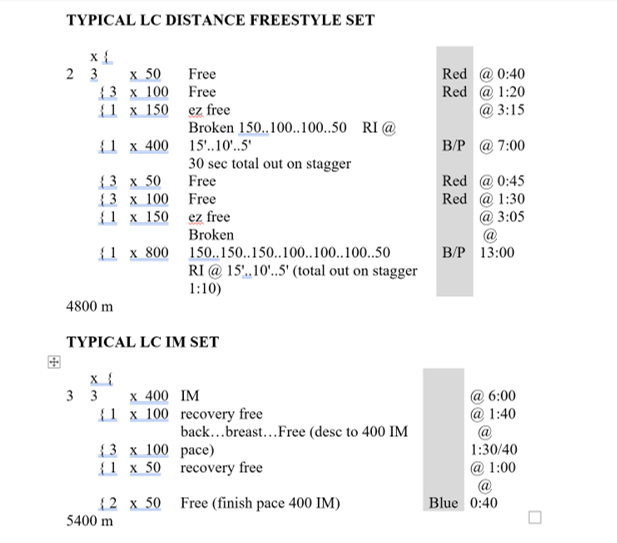
Photo Courtesy:
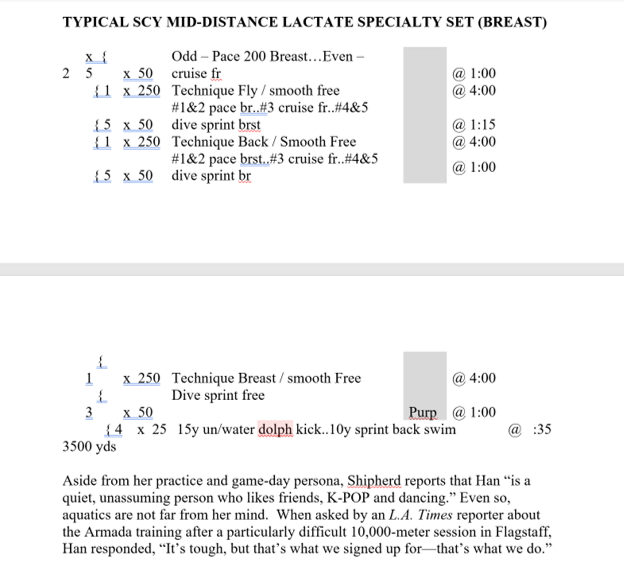
Photo Courtesy:
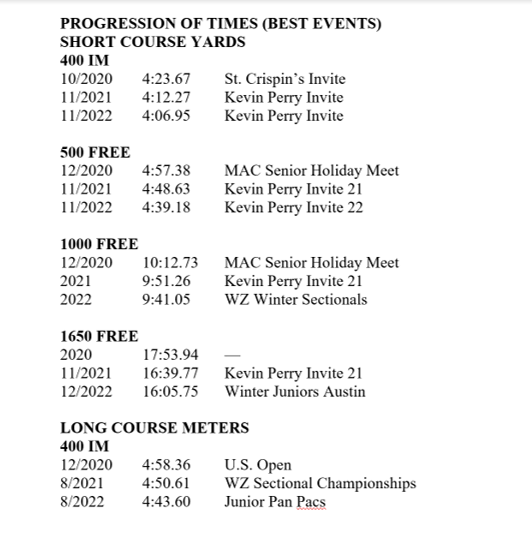
Photo Courtesy:
